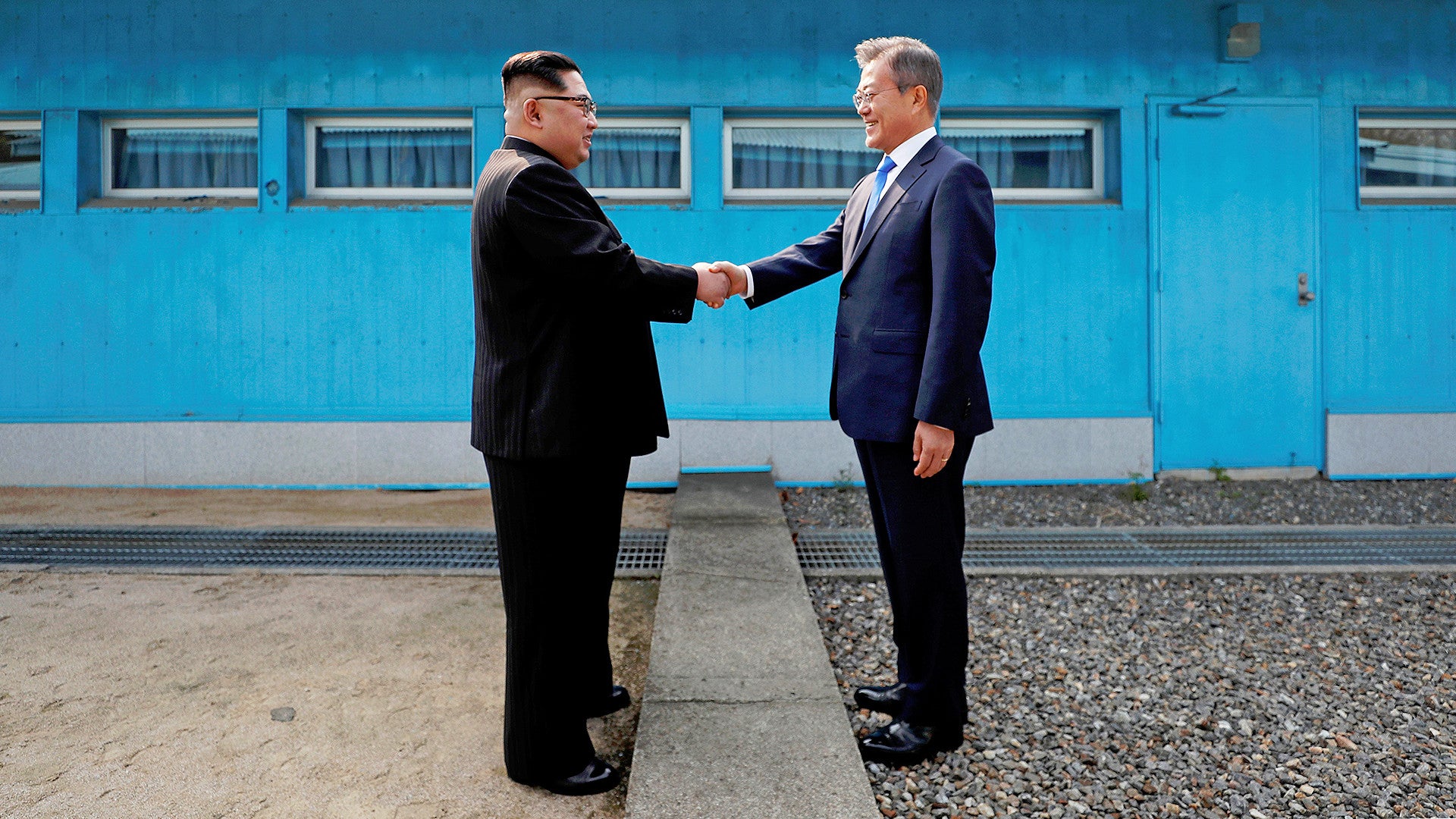More than five months after the same area erupted in gunfire as North Korean border guards tried to kill a soldier fleeing into the South, Panmunjom has hosted a historic summit between North Korea’s premier Kim Jong Un and South Korean President Moon Jae In. In a joint declaration, the two leaders pledged to end the war between their two countries, denuclearize the Peninsula and otherwise reduce tensions, establish a new joint liaison office with representatives on both sides of the demilitarized zone, or DMZ, help reconnect families the conflict had split apart, and work to improve ties in various other ways, including maybe upgrading North Korea’s rail network.
The event was notable right from the start, with Kim, flanked by a large security detail and an even larger entourage of other officials and aids, emerged from the Panmun Pavilion on the North Korean side of Panmunjom. He then walked to the low wall separating the two countries at the site and shook hands with Moon. In an unplanned and highly symbolic move, the South Korean president briefly crossed over into the North before both leaders stepped over into the South together holding hands.
“My heart won’t stop fluttering, to meet at such a historic location” Kim reportedly told Moon when they first met. Observers said the young ruler appeared visibly anxious – no doubt a mixture of excitement and apprehension about visiting a country with a stated policy of making him live in constant fear of assassination. “Also, I’m very moved that you have come all the way to [military demarcation line] to greet” Kim added.
“It was a very courageous decision for you to come all the way here,” Moon said in response.
The two leaders and their respective parties then moved on to the Peace House on the South Korean side of Panmunjom. Built in 1989 on the site of a temporary structure that hosted a meeting between North and South Korean Prime Ministers in 1990, this building has served as a location for various high-level engagements since then.
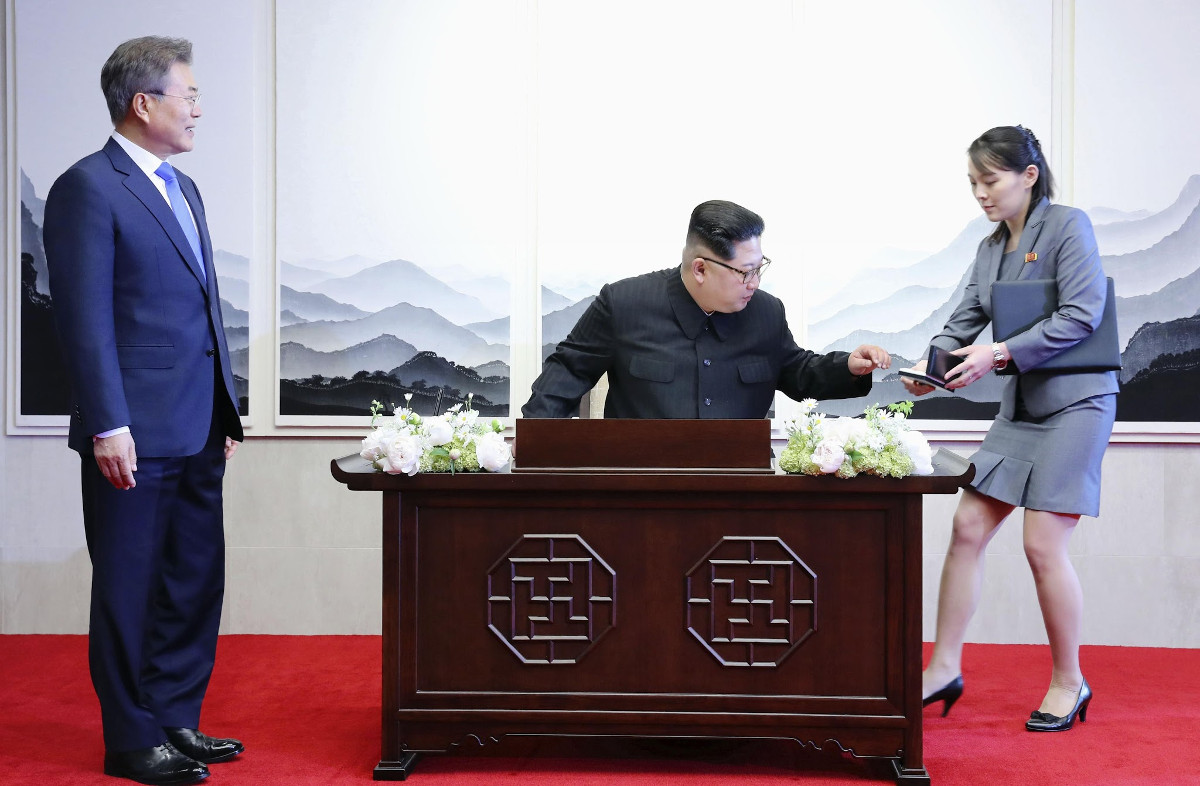
“A new history begins now,” Kim wrote in the guestbook. “At the starting point of history and the era of peace.”
“As I walked over here, I thought, why was it so difficult to get here?” Kim said as the two groups sat down for their initial meeting in the newly remodeled boardroom. “The separating line wasn’t even that high to cross. It was too easy to walk over that line and it took us 11 years to get here.”
“Chairman Kim, for the first time in our history you crossed the military demarcation line,” Moon said in his own remarks. “The military demarcation line is no longer a symbol of division but a symbol of peace.”
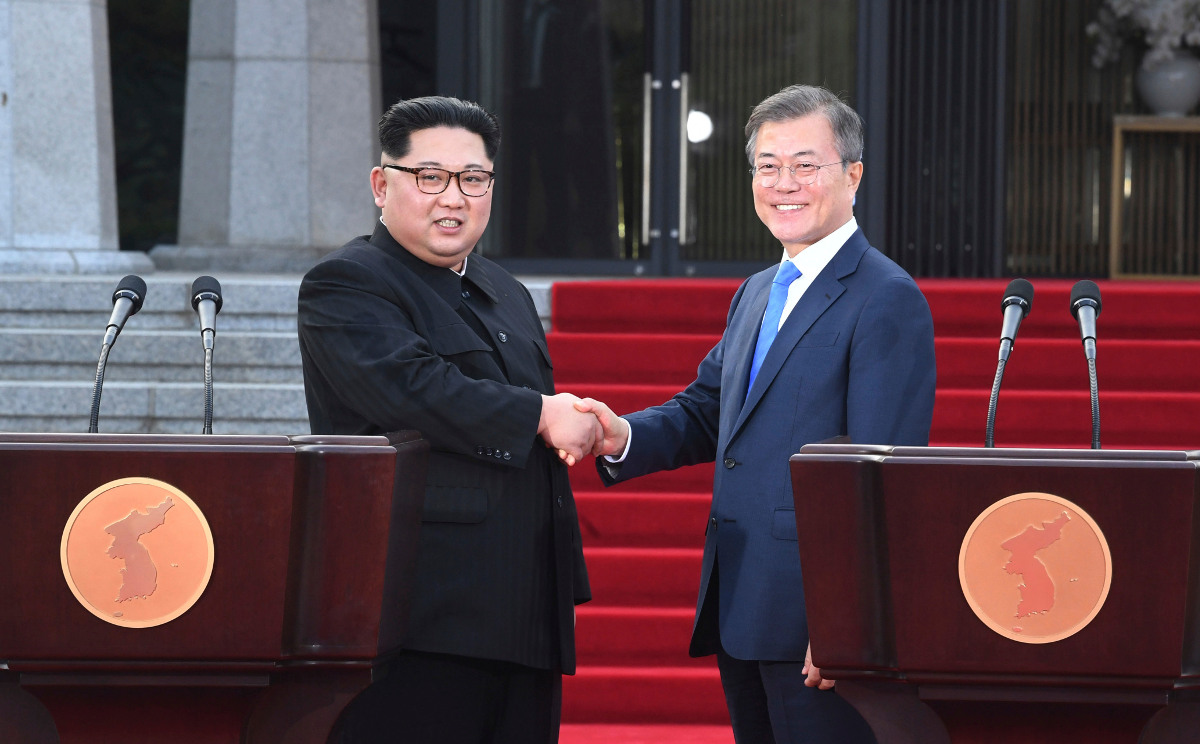
“Over the past seven decades we weren’t able to communicate, so I think we can talk the whole day today,” Moon added, reportedly drawing a laugh from Kim.
After the various public statements and photo-ops, the two sides set to work. Im Jong Suk, South Korea’s Chief Presidential Secretary, and Suh Hoon, chief of the South Korean National Intelligence Service – analogous to the U.S. Central Intelligence Agency – flanked Moon at the meeting. Kim Yong Chol, Vice Chairman of the Workers’ Party of Korea’s Central Committee and Kim Jong-un’s sister Kim Yo Jong, who acts as his personal adviser and also serves as Vice Director of the Central Committee, were also in attendance. The Workers’ Party of Korea is the formal name for the ruling Communist political party in North Korea.
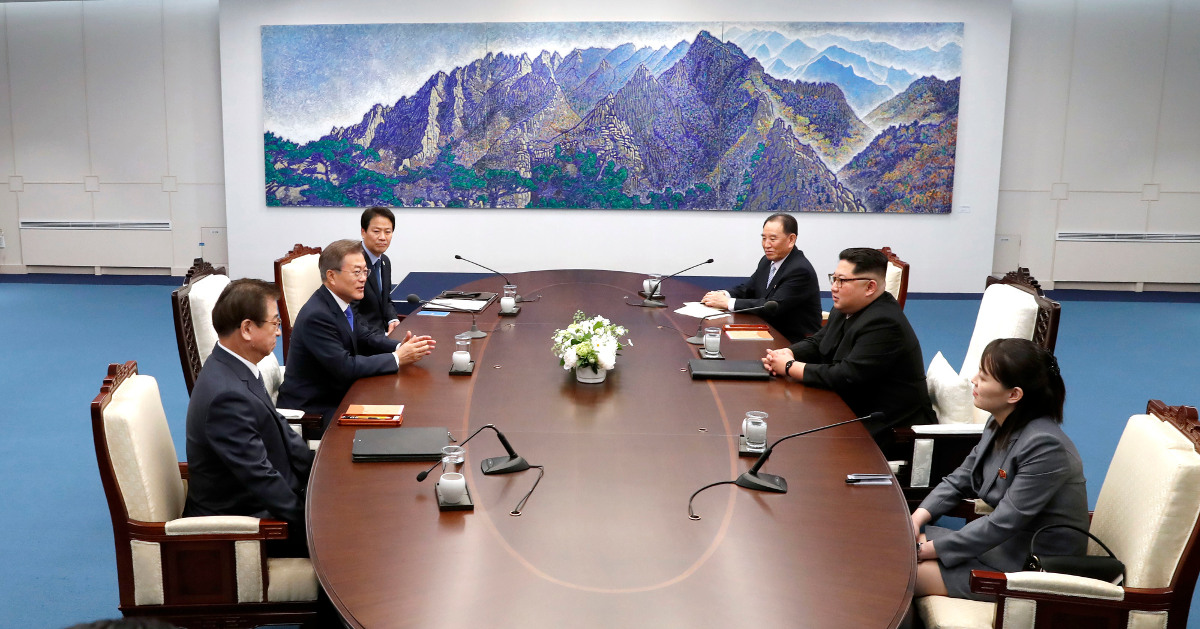
The two sides then broke for lunch on their respective sides of the DMZ before returning for more meetings at the Peace House. Kim’s security detail followed him jogged alongside his limousine as he departed the area. They performed this maneuver again when he returned and later in the evening when he departed after the summit came to an end.
Moon agreed in principle to visit Pyongyang and Kim said he would be equally willing to go to Seoul. In a rare acknowledgment of conditions inside North Korea, the country’s premier also said that there would have to be significant improvements to his country’s transportation networks ahead of the South Korean president’s arrival.
“If [Moon] comes to the North after living in the South, it may be embarrassing,” Kim said. “We will make preparations for a comfortable visit.”
The state of North Korea’s transportation networks was a particular issue. North Korean officials reportedly spoke of how impressed they were by South Korea’s high-speed rail networks and Kim himself talked about the possibility of expanding such a system all the way to the Chinese border in the future. Members of the North Korean delegation would have had experience with South Korea’s more advanced infrastructure just recently after taking part in the Winter Olympics in the South Korean city of PyeongChang.

Rail remains an especially important mechanism for travel and trade in North Korea and Kim recently used a specialized bullet-proof luxury train to travel to China in March 2018 for a secretive state visit. The country’s roads are notoriously poor and on the eve of the summit 32 Chinese nationals, along with four North Korean officials, died in a tour bus crash in North Korea.
“If the railroad is connected with the North, both the South and North can use high-speed trains,” Moon said. “This is contained in the joint declarations of June 15 [2000], and Oct. 4 [2007], but it has not been executed over the past 10 years.”
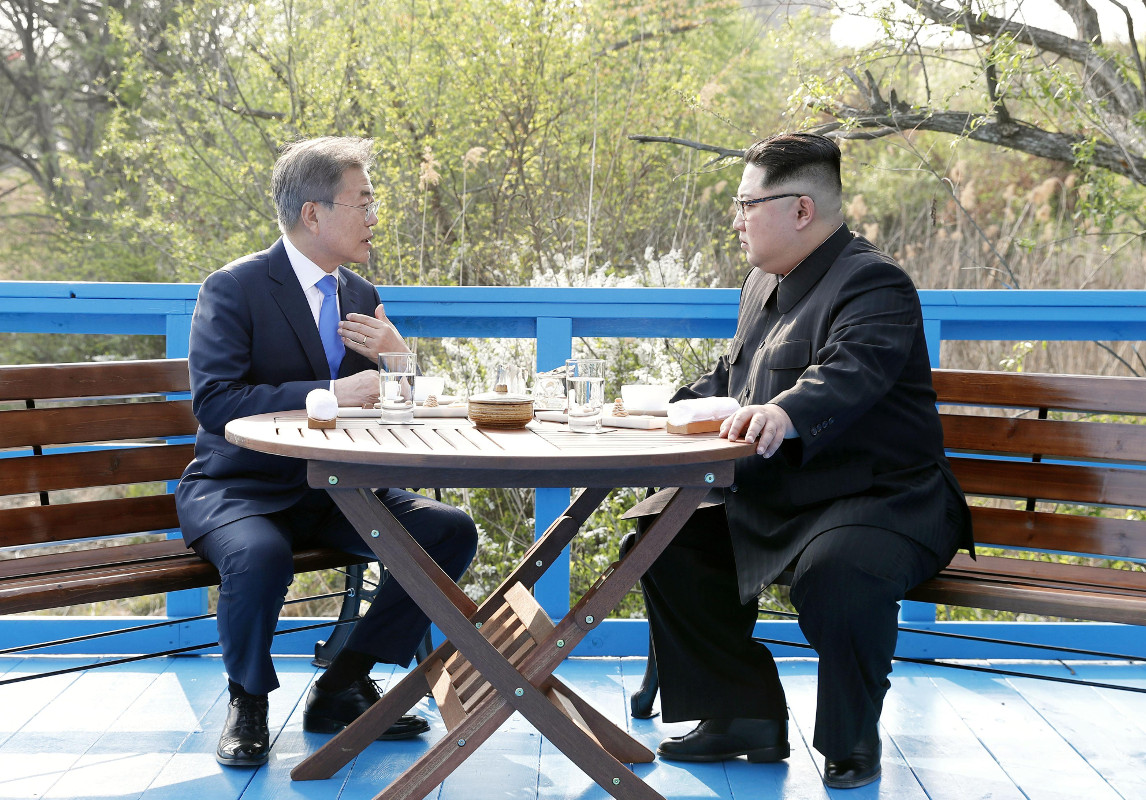
There was also a ceremonial tree planting near the DMZ, which was especially notable given that, in his time in the South Korean Army, Moon had participated in Operation Paul Bunyan in 1976. The mission involved cutting down trees along the DMZ under heavy security after North Korean border guards murdered U.S. Army Captain Arthur Bonifas and 1st Lieutenant Mark Barrett with their own axes when they initially attempted to remove one single poplar tree that was blocking their observation post. This infamous event has since become known as the Panmunjom axe murder incident.
The two Korean leaders then crossed a small a footbridge, which South Korean officials had painted in the symbolic blue representing future reunification, and walked along the DMZ. They eventually spent an unprecedented 30 minutes speaking effectively alone without any other advisers or aides. There was then a banquet with more speeches and specially prepared North and South Korean dishes, as well as a concert before Kim departed and returned to the North.
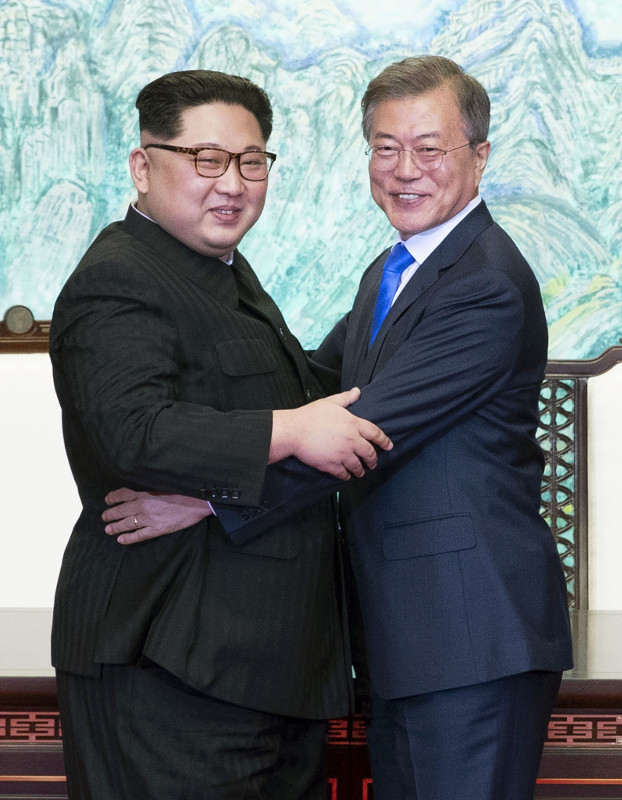
As the jam-packed day of meetings and events came closer to its conclusion, the two sides had also revealed they had signed a multi-part declaration, which you can read in full below:
The call for an end to the Korean War is significant, as the two sides remain technically at war after 65 years. An armistice officially ended the outright fighting in 1953, though clashes and other violent alterations have continued ever since, but there is no peace treaty to bring the conflict to an end.
But there could be significant hurdles in achieving that goal, not least of which that it would more formally establish two independent Koreas and push the possibility of reunification, long a goal of both sides, indefinitely into the future. Various foreign parties, most notably the United States, would also have to agree to rescind a number of United Nations Security Council resolutions that provide an international mandate to maintain a military presence on the Peninsula to deter North Korean aggression. The U.S. government is a permanent member of the Security Council and can veto any new resolution unilaterally for any reason.
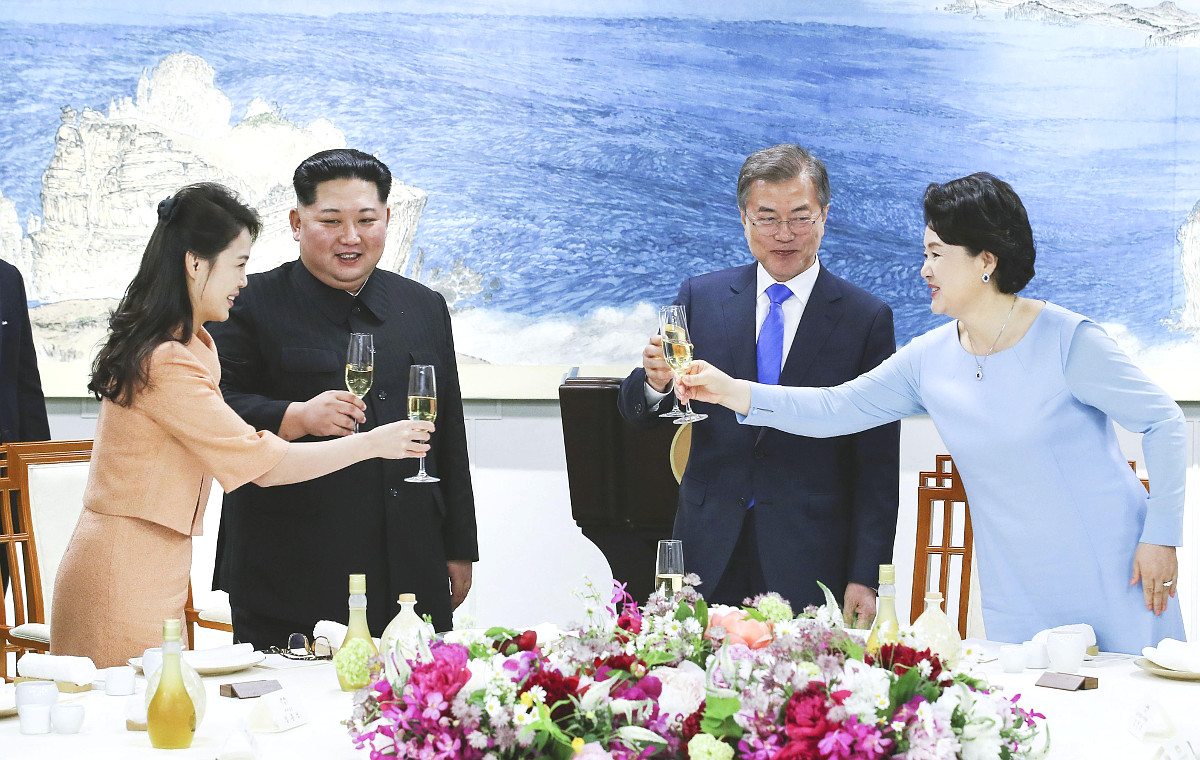
“We are not a people that should be confronting each other … we should be living in unity,” Kim said. “We have long waited for this moment to happen. All of us.”
“The road I have used today, I sincerely hope every South and North Korean citizen can use this road,” Kim continued. “We will be able to enjoy peace and prosperity on the Korean Peninsula without having to fear the war.”
He did not specifically mention denuclearization in his prepared remarks, but Moon later said both sides had agreed to completely denuclearization the Korean Peninsula. Unfortunately, it remains unclear whether or not the two sides agree on the definition of denuclearization, which North Korea has long called for, but clearly understands does not include giving up its own nuclear arsenal, at least without massive concessions.
Instead, the North Korean regime has typically understood this to mean the removal of the threat of U.S. nuclear strikes, which would involve ending agreements that put South Korea, as well as nearby Japan, under America’s deterrent umbrella. This, along with plans to “end” the Korean War, are almost certainly linked to the border desire on the part of the government in Pyongyang to eliminate the raison d’être for American troops to remain on the Peninsula at all.
As such, the goal to “completely cease all hostile acts against each other in every domain,” could be equally hard to turn into a reality, especially since this would almost certainly mean an end to shared U.S.-South Korean military exercises, which North Korea repeatedly insists are simply dry runs for an invasion. Coupled with Kim’s proposed freeze on missile and nuclear weapons testing, South Korea’s pledge to halt propaganda broadcasts and leaflet drops across the border, as well as plans to turn the West Sea – the site of numerous violent clashes over the years, which have led to the deaths of South Korean military personnel and innocent civilians – into a neutral economic zone, could have more immediate effects on reducing tensions.
“[I] won’t interrupt your early morning sleep anymore,” Kim reportedly joked with Moon, referring to his recent flurry of ballistic missile tests, including the demonstration of a nuclear-capable intercontinental ballistic missile.
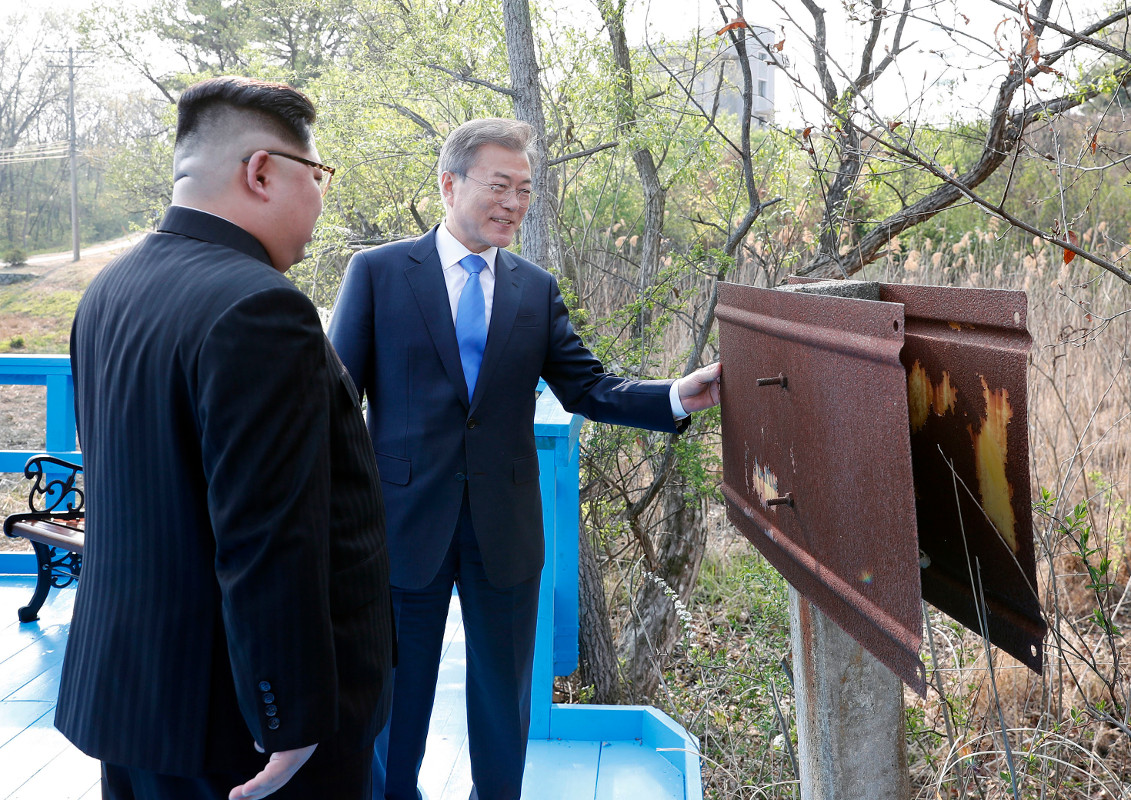
Calls for improving the ability for divided families to meet and otherwise communicate, as well as increased economic and other cooperation, such as a potential joint participation in the 2018 Asian Games in Indonesia, which start in August 2018, are hardly new concepts. The closure of a shared industrial park and a halt in scheduling new family visits were among the first casualties of the latest burst of heightened tensions on the Peninsula.
It is also worth noting that this meeting, likely the first in a series, did not address North Korea’s gross human rights violations, the country’s illicit economic activities, or the assassination of Kim’s half-brother Kim Jong Nam in Malaysia in February 2017. Despite all the smiles and laughter, it’s impossible for these issues not to come up eventually and protesters flocked to the South Korean side to denounce Moon’s decision to meet with Kim.
It’s not the first time leaders from both sides have met, either. South Korean Presidents Kim Dea Jung and Roh Moo Hyun both met with Kim’s father Kim Jong Il, in 2000 and 2007, respectively, without any meaning progress come from those engagements. Both of those events occurred in Pyongyang, though, which could indicate both parties believe this time might be different.
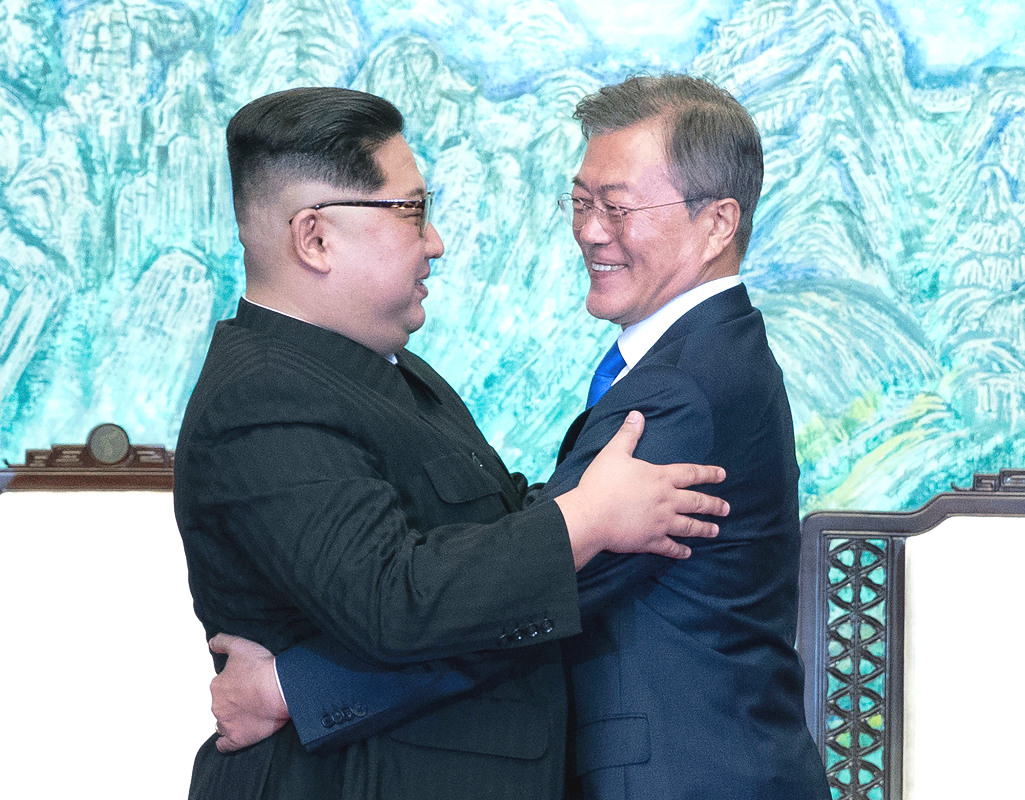
None of this is to say that the meeting doesn’t appear to be a largely positive step in intra-Korean relations and for reducing the likelihood of a catastrophic conflict on the Peninsula. As The War Zone’s own Tyler Rogoway previously wrote after Kim announced his missile and nuclear testing moratorium:
Some will say North Korea has made agreements and broken them before. That’s true, but the immediate threat of snap-back sanctions and a preemptive strike is a powerful tool now on the table. Additionally, Kim Jong Un is not his father or his grandfather. He has been remarkably open about his intentions and capabilities, and if he gets a taste of even granular respect on the world stage, it could lead to real reforms. Also keep in mind the drastically different relationship the North has with the South now after just a couple months of talks. For Kim to backtrack on all this just to test nuclear bombs and launch rockets, while also sending his economy back into a death spiral, seems totally illogical.
…
So the fact that Kim’s star is rising on the world stage, and he seems to really like this fact, is a good development that can be readily exploited. In essence, his increasing connection with the greater world community is the most probable catalyst that could bring about a major change on the Korean Peninsula. This critical observation needs to be carefully factored into the aims of Trump-Kim summit.
By providing him a series of stepping stones where his ego won’t be obliterated in the process of stepping away from his nuclear stockpile, it may actually happen. He can first claim a strategic win for his people, saying his goals of achieving a nuclear deterrent are achieved, and then once trust is built with external parties, he can be offered an incredibly lucrative opportunity to usher his people into a new age.
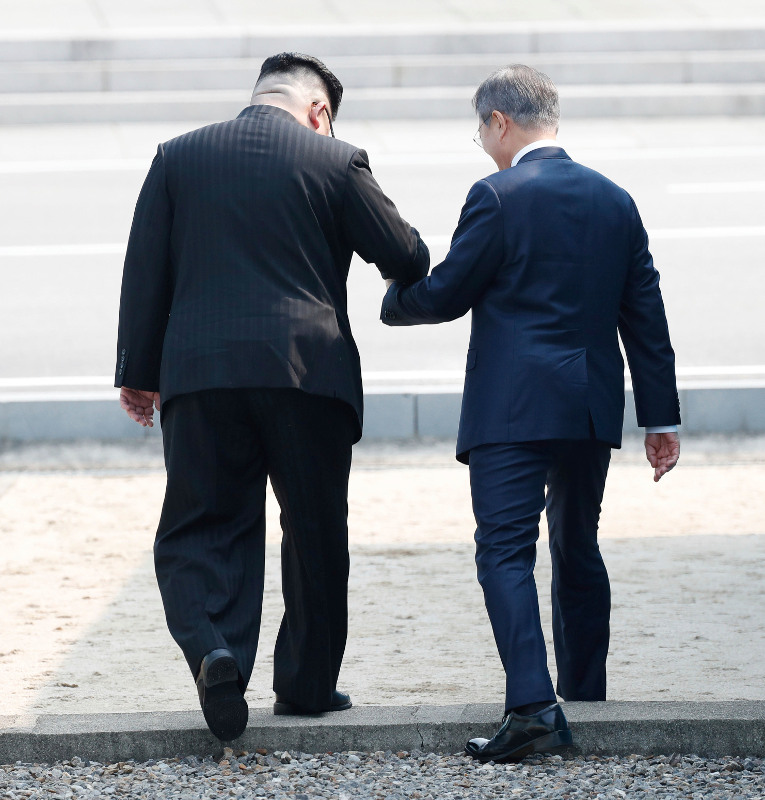
The same goes for this summit, as well as the still reportedly forthcoming meeting between U.S. President Donald Trump and Kim. After the meeting Trump took to his favorite outlet, Twitter, to declare the Korean War was set to end, which remains to be seen, as well as applaud the work of China, North Korea’s principal foreign ally, in pushing for the talks. “Disasters are never powerful enough to separate real brothers, and a smile is all they need to eliminate the hard feelings,” China’s foreign ministry said in its own statement, citing an ancient Chinese poem.
How Trump’s summit might go could also have serious ramifications, especially if the United States demands immediate and total denuclearization as it defines it, which is likely to be the total and verifiable elimination of North Korea’s nuclear weapons and infrastructure and raw materials to produce additional devices. Not only is that likely to be a non-starter for North Korea, it could also be near impossible to ensure the North Koreans are complying.
If those talks break down, it could prompt a more serious divergence in policy between the South Korean and American governments over how to handle the situation. The U.S. government was initially dismissive of the possibility of productive talks between Moon and Kim, stressing that it was under no obligation to abide by any terms the two Koreas set for themselves.
North Korea is very likely to treat this summit, like the lowered tensions leading up to the summit, as a major victory that validates the legitimacy of their state, as well as the regime’s decision to pursue a nuclear deterrent seemingly at all costs. North Korea’s state television pointedly did not broadcast the event live, unlike South Korean and Chinese outlets. This could be due to technical limitations, but at the time of writing, the Korean Central News Agency had yet to issue any commentary either. North Korea’s heavily scripted state media is likely poring over exactly how to frame the summit domestically to a populace that is routinely told that the South Korean government is a vicious enemy and puppet of the United States.
All told, it is still too early to say for sure how well the two Koreas will be able to implement the tenets of their joint declaration and how long those initiatives might last. At the same time, it is undoubtedly a positive that the two sides decided to choose diplomacy and significant gestures toward stability and ultimate peace, over the inflammatory rhetoric that has been predominant on all sides over the past 18 months and a potentially devastating all-out conflict.
Contact the author: jtrevithickpr@gmail.com
